January 2025
The global digital therapeutics market size is calculated at USD 9.73 billion in 2025 and is forecasted to reach around USD 56.76 billion by 2034, accelerating at a CAGR of 21.83% from 2025 to 2034. The North America market size surpassed USD 3.02 billion in 2024. The market sizing and forecasts are revenue-based (USD Million/Billion), with 2024 as the base year.
The global digital therapeutics market size was estimated at USD 7.88 billion in 2024 and is predicted to increase from USD 9.73 billion in 2025 to approximately USD 56.76 billion by 2034, expanding at a CAGR of 21.83% from 2025 to 2034.
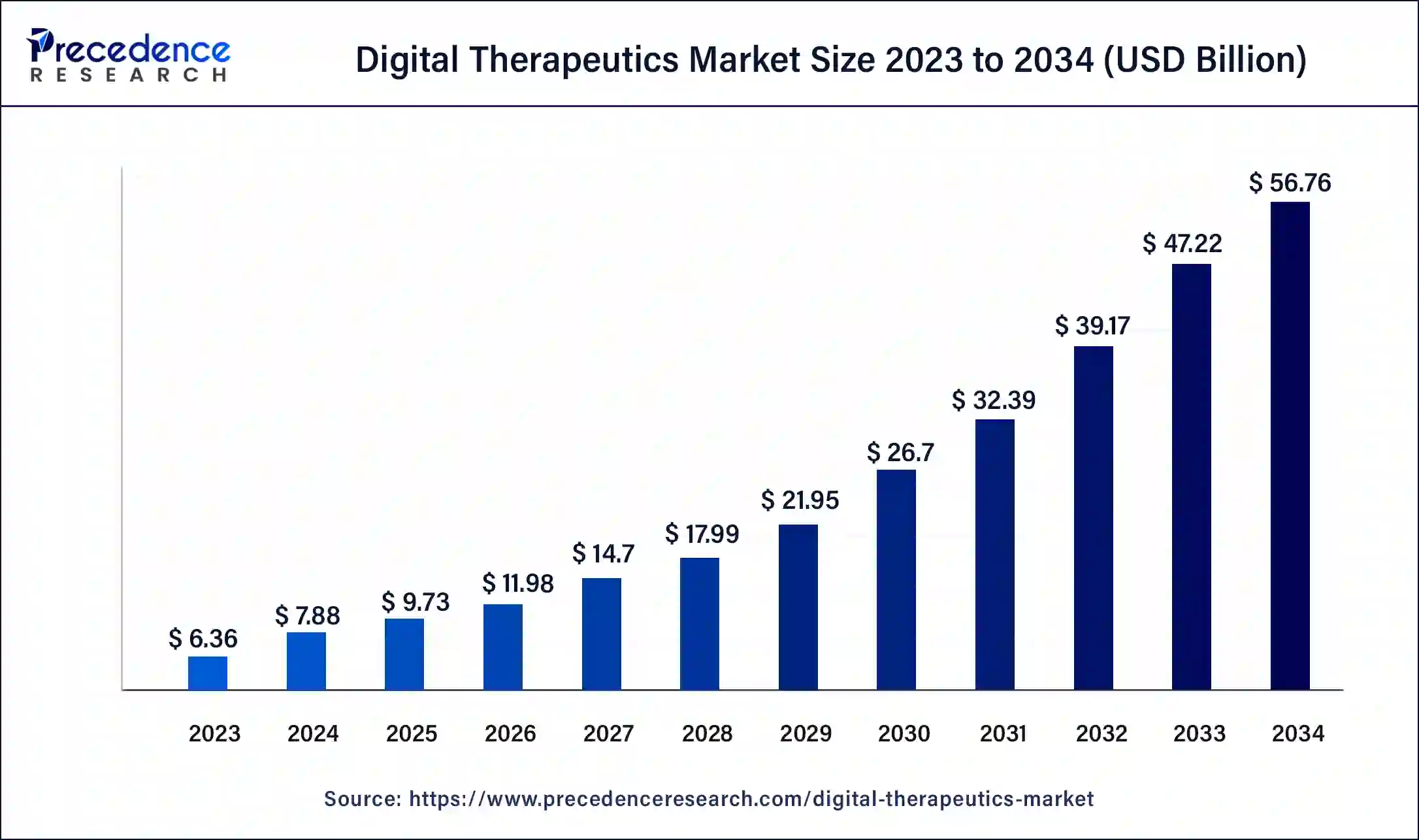
The U.S. digital therapeutics market size was estimated at USD 3.02 billion in 2024 and is predicted to be worth around USD 20.98 billion by 2034, registering a solid CAGR of 21.38% between 2024 and 2034.
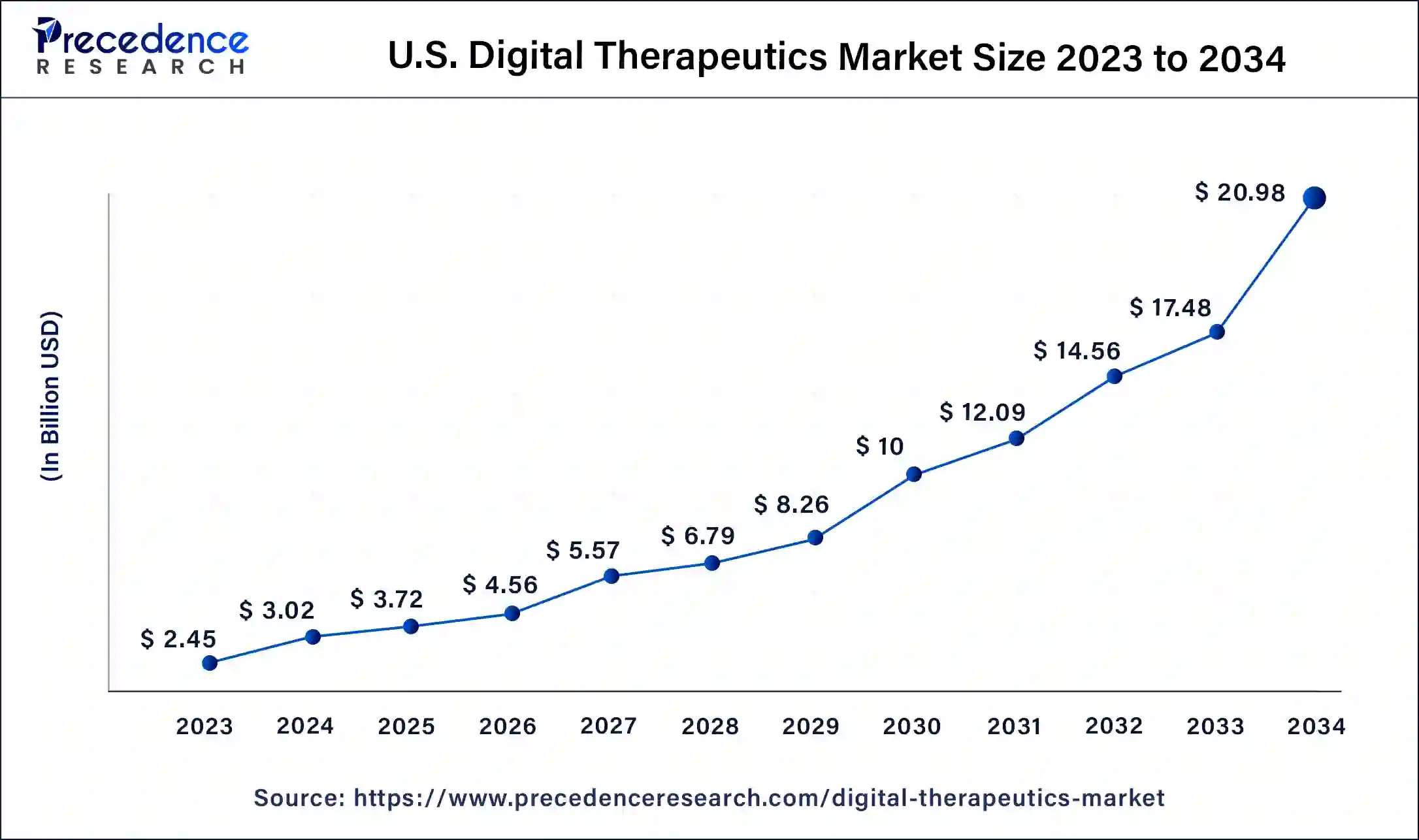
North America emerged as a global leader in the global digital therapeutics market with a revenue share of 44.03% in 2023 owing to the increasing number of reforms pertaining to curtail the rising healthcare spending across the region. Furthermore, the region is a hub for a large number of solutions providers for digital therapeutics that again drive the market growth in the region.
The digital therapeutics market expansion in this region is fueled by factors such as the entry of new startups, changes in the reimbursement structure of digital therapeutics, increased investments in digital therapeutics, and growing government initiatives to assist technological developments.
Apart from this, the Asia Pacific expected to witness the fastest growth over the analysis period because of large consumer base along with rising geriatric population in the region. Due to its early acceptance of new and innovative technology, and increased investment through funding, the Asia-Pacific is likely to dominate the market. The investment is related to increased government investment, and mergers and acquisitions.
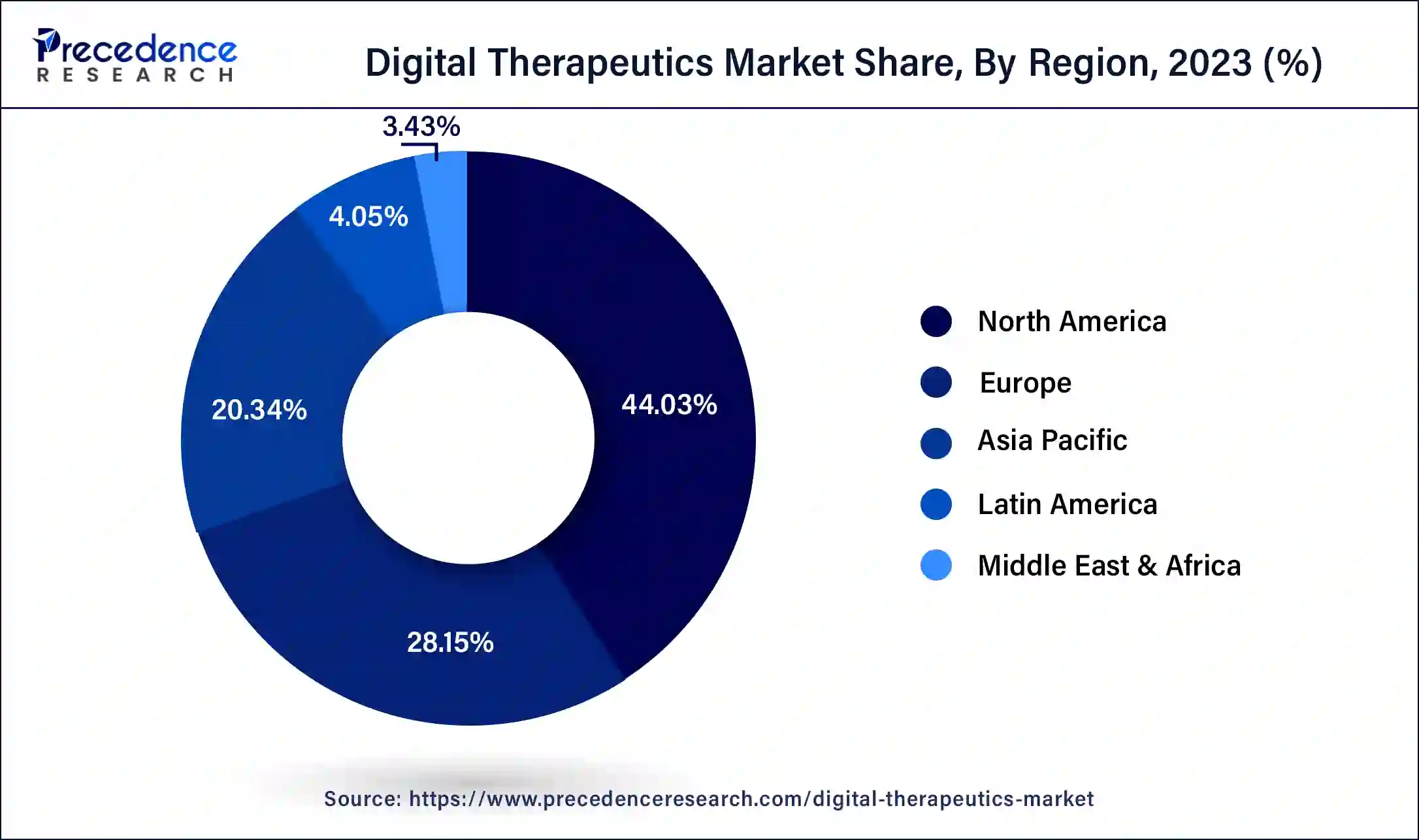
The patients can receive evidence-based treatment interventions using digital therapies. It is used to manage, prevent, or treat medical conditions using software applications and equipment. To provide patient care and health results, the digital therapeutics software can be used alone or in conjunction with other therapies.
The rising frequency of preventable chronic disorders such as cancer and diabetes, the need to control healthcare costs, increased investments in digital medicines, and a growing focus on preventive healthcare are all driving the growth of the digital therapeutics market.
One of the key factors driving the growth of digital therapeutics market is the rising focus on preventative healthcare by governments around the world. The governments are taking steps and implementing programs to increase the rate of use of these devices, which is a shift from the traditional healthcare methods.
Increasing penetration of digital healthcare applications & platforms because of rapid adoption of smartphones & tablets expected to spur the market growth over the upcoming years.
Rising prevalence of chronic diseases coupled with increasing need to regulate the escalating cost of healthcare facilities is likely to impel the market growth. Further, constantly changing digital platforms in various sectors has grappled consumers towards using of these digital platforms as well as increasing awareness pertaining to health and fitness are the primary factors that boost the market growth over the forthcoming timeframe.
Although digital therapeutics witnesses significant development and numerous advancements, it is still at a niche phase and the application developers face lot of difficulty due to lack of proper monetization strategy. Presently, advertisements along with the paid content are the prime source of revenue generation, yet are insufficient to meet the financial requirements. The aforementioned factors are anticipated to adversely affect the market growth.
| Report Scope | Details |
| Market Size in 2034 | USD 56.76 Billion |
| Market Size in 2025 | USD 9.73 Billion |
| Market Size by 2024 | USD 7.88 Billion |
| Growth Rate From 2024 to 2034 | CAGR of 21.83% |
| Dominating Region | North America |
| Fastest Growing Region | Asia Pacific |
| Base Year | 2024 |
| Forecast Period | 2025 to 2034 |
| Segments Covered | By Product, By Application, and By Sales Channel |
| Regional Scope | North America, Europe, Asia-Pacific, Latin America, and Middle East & Africa |
Growing geriatric population
The growing geriatric population globally is one of the primary factors driving up demand for digital therapeutics. The global population of people aged 60 and up is expected to reach 2.1 billion by 2050, according to the United Nations. People over the age of 60 are more susceptible to illnesses such as obesity, cancer, and diabetes, increasing the demand for digital therapeutics. Thus, during the forecast period, the growing geriatric population is driving the growth of the digital therapeutics market.
Data privacy concerns
The various health applications lack necessary authorization in several countries, raising issues about the product and data quality, patient privacy, security, and data use responsibly. The patient’s information is accessible by digital therapeutics providers, but they are not allowed to share it with anybody who is not involved in the patient’s treatment. However, with the use of digital technologies to integrate data, the patient’s information is at risk of being accessible by any healthcare professional who is not involved in the patient’s treatment program. Thus, the data privacy concerns is hindering the growth of digital therapeutics market during the forecast period.
Rising prevalence of chronic diseases
The chronic disease’s high prevalence is a key source of concern for healthcare systems all over the world. The treatment of chronic disorders patients is difficult due to psychological variables influencing the patients. The patients must adapt their behavior as a part of new self-care lifestyle because chronic diseases are generally linked with a high level of unpredictability. Moreover, many chronic diseases and ailments progress with the time, and their prevalence increases as people get older. As a result, chronic problems are likely to increase even more in the coming years as the global senior population continues to grow. As a result, the rising prevalence of chronic diseases is creating lucrative opportunities for the growth of digital therapeutics during the forecast period.
Lack of consumer awareness
Motivating people to use digital therapeutics and gaining their trust is a major challenge for providers of digital therapeutics. The old age people are more vulnerable to the chronic disorders. Furthermore, the extent to which behavioral change can be observed with digital therapeutics remains unknown.
The devices segment dominated the market in 2023, accounting for 87.38% market share. The segment growth is mainly attributed to the increasing usage of wearable devices and monitoring tools among physicians as well as patients. Digital health devices enable remote healthcare. The rising instances of chronic diseases further contributed to the increased adoption of digital healthcare devices, as some chronic diseases, including diabetes, cardiovascular diseases, and respiratory diseases, require regular monitoring to manage conditions. For instance,
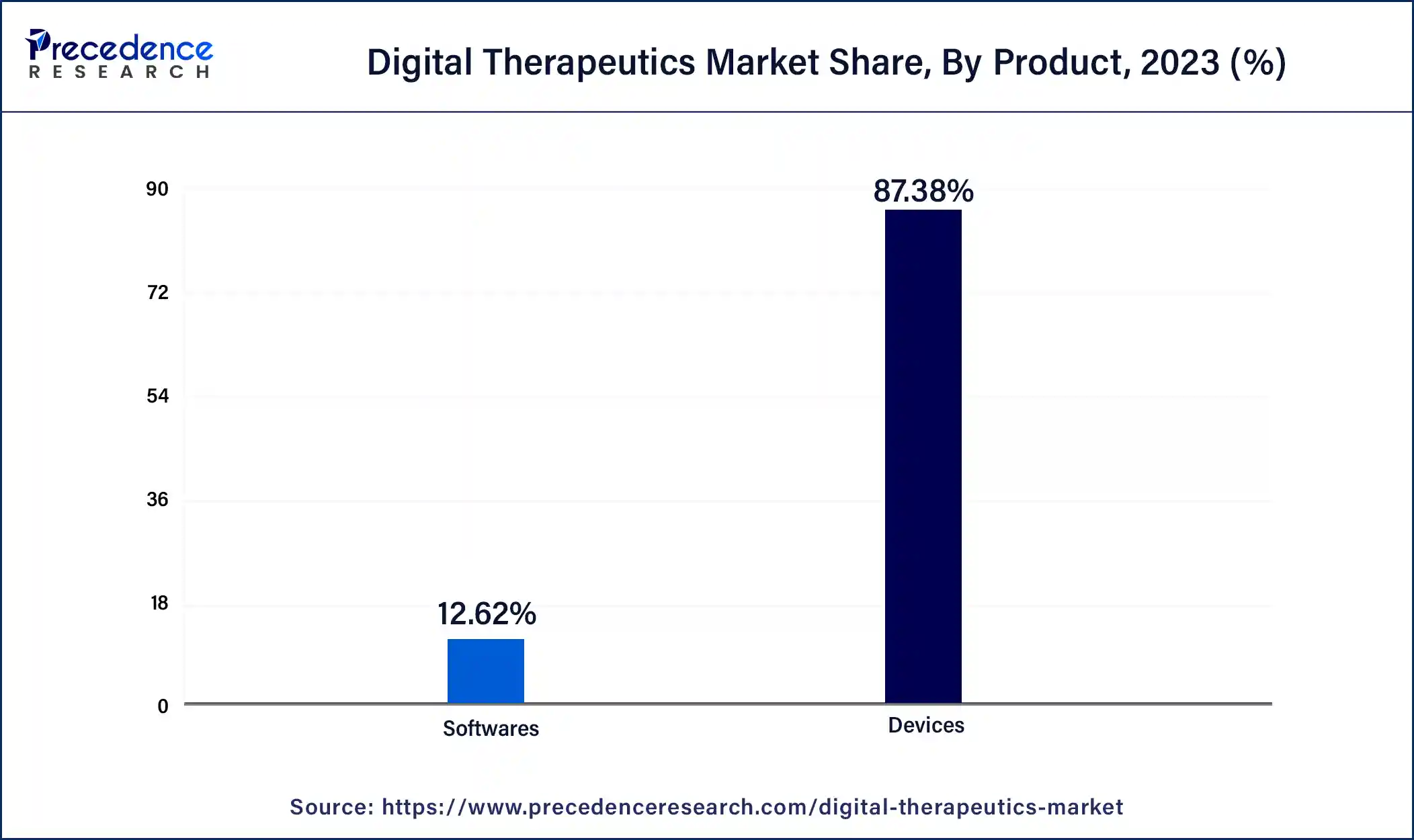
Global Digital Therapeutics Market Revenue, By Product, 2022-2023(USD Million)
| Product | 2022 | 2023 |
| Devices | 4,489.61 | 5,559.01 |
| Softwares | 632.49 | 802.64 |
Based on application, the diabetes segment accounted market share of 26.46% in 2023 owing to the rising prevalence of disorders such as diabetes and the rising expenses of treatment. As per the stats published by American Diabetes Association, around 10.5% of America population suffered from diabetes in 2018 out of which 21% were undiagnosed. In addition, 1.5 Million of new cases are diagnosed with diabetes every year. In the United States, diabetes costs nearly USD 350 Billion including both direct medical cost as well as reduced productivity costs. In order to regulate this, digital therapies are booming with their effectiveness in several aspects.
Apart from this, obesity is the other major concerned disease that expected to exhibit the fastest growth over the forthcoming years. Changing eating habits largely influenced by the western pattern that contains packaged foods with high fat contents are primary cause for increase in the cases of obesity. Furthermore, hectic life style and daily routine reduces the frequency of exercises and daily warm ups that again attributed as the major factor for the collection of fat in body. In order to control this, general public are prominently influenced by the apps related to fitness along with online assistance from concerned doctors, this helps in tracking daily physical activity and health data.
Global Digital Therapeutics Market Revenue, By Application, 2022-2023(USD Million)
| Application | 2022 | 2023 |
| Obesity | 909.72 | 1,145.22 |
| Diabetes | 1,361.66 | 1,683.53 |
| CNS Disorders | 623.75 | 776.32 |
| Gastrointestinal Disorders | 580.40 | 723.58 |
| CVD Disease | 685.62 | 847.21 |
| Smoking Cessation | 229.47 | 282.54 |
| Respiratory Diseases | 422.58 | 527.63 |
| Others | 308.91 | 375.61 |
The business-to-business (B2B) segment led the digital therapeutics market in 2023. Digital therapeutics are particularly effective in managing chronic diseases such as diabetes, hypertension, and mental health disorders. B2B customers, such as healthcare providers and employers, face significant costs related to these conditions and thus have a strong incentive to adopt digital therapeutics to manage them more efficiently. Digital therapeutics offer robust data analytics capabilities, providing healthcare providers and employers with actionable insights into patient or employee health trends. This data can be used to personalize treatments, improve health outcomes, and demonstrate the value of these solutions. These solutions are designed to integrate with existing healthcare IT systems, such as EHRs and health information exchanges (HIEs), facilitating seamless data flow and enhancing the overall care delivery process.
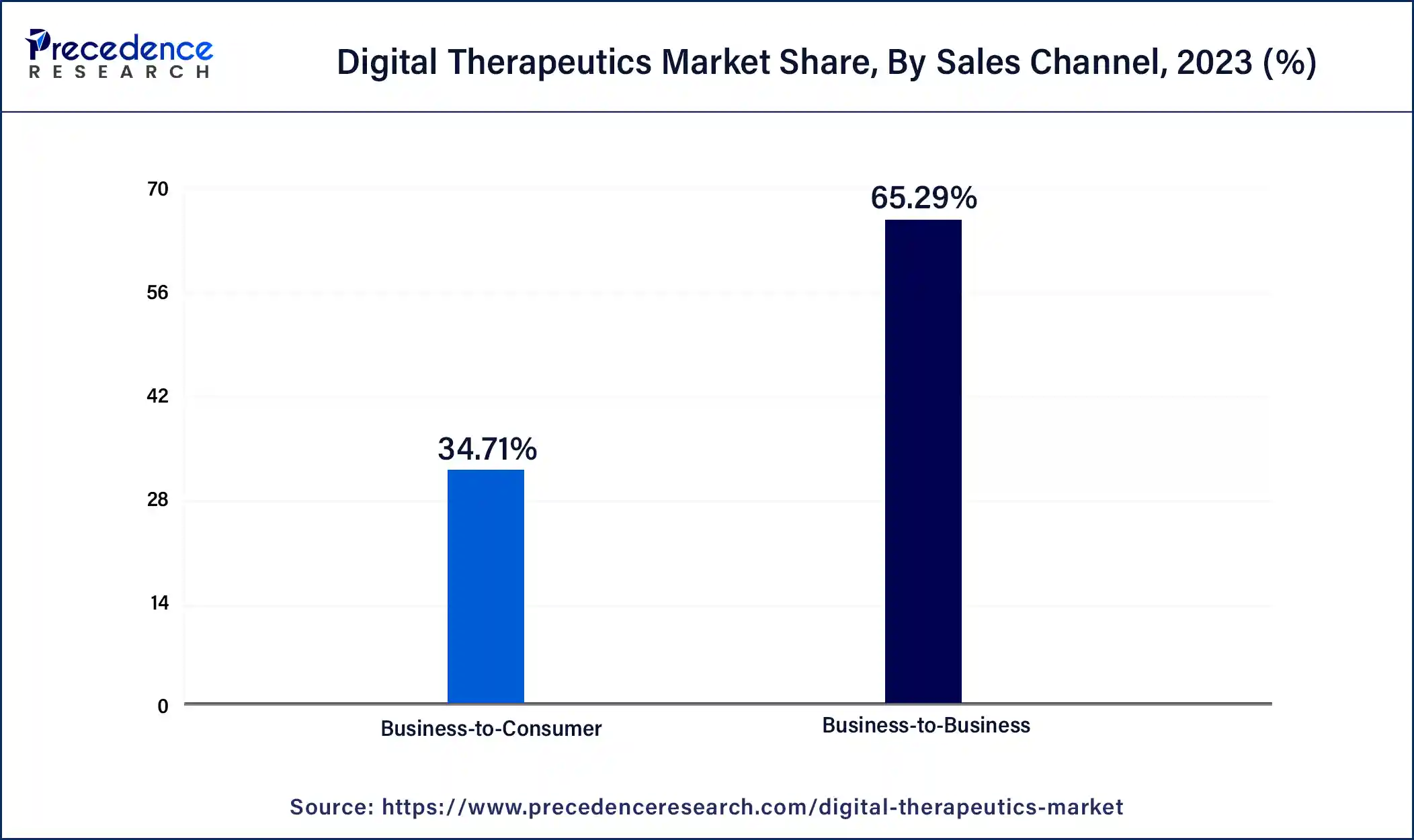
Segments Covered in the Report
By Product
By Sales Channel
By Application
By Regional Outlook
For inquiries regarding discounts, bulk purchases, or customization requests, please contact us at sales@precedenceresearch.com
No cookie-cutter, only authentic analysis – take the 1st step to become a Precedence Research client
January 2025
January 2025
January 2025
December 2024